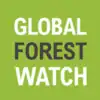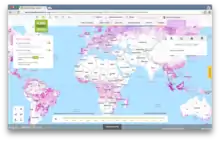Global Forest Watch
Global Forest Watch (GFW) is an open-source web application to monitor global forests in near real-time. GFW is an initiative of the World Resources Institute (WRI), with partners including Google, USAID, the University of Maryland (UMD), Esri, Vizzuality and many other academic, non-profit, public, and private organizations.
 | |
Screenshot  GFW map (2015) | |
| Owner | World Resources Institute |
|---|---|
| URL | www |
| Commercial | No |
| Launched | February 22, 2014 |
| Current status | Online |
| Written in | HTML, Ruby, JavaScript, CSS, Shell |
History
Global Forest Watch originally began in 1997 as an initiative to establish a global forest monitoring network, convened by the World Resources Institute and partners.
The initiative was rebooted in 2013 with data from the Center for Global Development derived from NASA's MODIS sensor, with additional layers subsequently added from Google/UMD, Imazon, Terra-i, and NASA.[1][2][3][4][5] The second iteration of GFW was released in February 2014, and continues to add information at multiple time scales and spatial resolutions to track deforestation.[6][7] The GFW Commodities and GFW Fires sub-pages were subsequently released.[8][9][10][11]
Use cases
The GFW platform has been used in a number of notable applications. The forest change data have been used to measure global deforestation rates and to detect and monitor illegal clearing activity, primarily in Indonesia.[12][13][14][15] The NASA Active Fires data, displayed within GFW Fires, have been used to identify illegal burning that has caused the 2015 Southeast Asian haze crisis (see Haze crisis). Multinational companies use the GFW platform to track their supply chain, purportedly ensuring that they meet "no deforestation" commitments.[16][17][18]
Data sets
There are currently five categories of data sets available on the GFW site, which are updated at various frequencies and available at various spatial resolutions.
Forest Change Data
- Brazilian Amazon SAD alerts
- Near-global QUICC alerts
- Humid tropics FORMA alerts
- Tree cover gain
- Latin America Terra-i alerts
- Tree cover loss
- NASA Active Fires
- Guatemala Forest Change 2001-2010
- USA land cover change 2001 to 2011
Forest Cover Data
- Tropical forest carbon stocks (2000)
- Indonesia primary forest (2000)
- Indonesia peat lands (2002)
- Indonesia land cover (2006)
- Mangrove forests
- Tree cover (2000)
- Intact Forest Landscapes (2000)
- Brazilian Amazon SAD alerts
- USA Land Cover (2011)
- Global Land Cover
- Cameroon Forest Management Units
- Guatemala Forest Cover
- Romania tree cover
Forest Use Data
- Logging concessions (select countries)
- Wood fiber concessions (select countries)
- Mining concessions (select countries)
- Oil palm concessions (select countries)
- Eucalyptus concessions (select countries)
- Major dams
- Forest titles (select countries)
Conservation Data
- Tiger Conservation Landscapes
- Terai Arc Landscape Corridors
- Indonesia forest moratorium
- Biodiversity hotspots
- Alliance for Zero Extinction Sites
- Protected areas
- Endemic Bird Areas
- Indonesia oil palm suitability standard
People Data
- Resource rights (select countries)
- Indigenous lands (select countries)
- Population density (2000)
Haze crisis
GFW contributed notable data and analysis to reporting on the 2015 Southeast Asian haze crisis, including revealing that approximately 35% of the fires in Indonesia occurred in agricultural concessions.[19][20][21] This reporting linked the forest fires to specific companies.[22]
Awards
References
- MacDonald, Lawrence (18 March 2013). "Protecting Forests with Global Forest Watch 2.0 – David Wheeler and Nigel Sizer". CGD Podcast (Podcast). Retrieved 10 November 2015 – via Center for Global Development.
- Stahl, Susanne (22 January 2014). "Global Forest Watch: Measuring deforestation in real-time". The Metric. Yale University. Archived from the original on 4 March 2016. Retrieved 10 November 2015.
- Hammer, Dan; Kraft, Robin; Wheeler, David (2014). "Alerts of forest disturbance from MODIS imagery". International Journal of Applied Earth Observation and Geoinformation. 33: 1–9. doi:10.1016/j.jag.2014.04.011.
- Hansen, Matthew; Popatov, Peter; et al. (2013). "High-Resolution Global Maps of 21st-Century Forest Cover Change". Science. 342 (6160): 850–853. doi:10.1126/science.1244693. PMID 24233722.
- "Satellite Data for the People: USAID Supports Launch of New Forest Watch Tool". Impact Blog. United States Agency for International Development. 21 February 2014. Retrieved 11 November 2015.
- McGrath, Matt (21 February 2014). "New online tool tracks tree loss in 'near real time'". BBC News. Retrieved 10 November 2015.
- Newman, Lily (21 February 2014). "This Mapping Service Lets Us Watch Forests Shrink". Slate. Retrieved 10 November 2015.
- Stockton, Nick (1 July 2014). "How a New Map of Palm Oil Plantations Could Help Save Rainforests". Wired. Retrieved 10 November 2015.
- Hansen, Lexine; Ciciarelli, Carolyn (15 February 2015). "Global Forest Watch-Fires: Improving Remote Sensing Through Community Engagement". AAAS 2015 Annual Meeting. San Jose, CA. Retrieved 10 November 2015.
- "Global Forest Watch Fires". World Resources Institute. Retrieved 10 November 2015.
- "Global Forest Watch Commodities". World Resources Institute. Retrieved 10 November 2015.
- Schwartz, Ariel (16 March 2015). "Inside The Satellite Detective Agencies That Catch The Companies Destroying The Planet—From Space". Co.Exist. Retrieved 10 November 2015.
- Keenan, Rod (7 September 2015). "Forest loss has halved in the past 30 years, latest global update shows". The Conversation. Retrieved 11 November 2015.
- Matthews, Emily; Grainger, Alan. "Evaluation of FAO's Global Forest Resources Assessment from the user perspective". FAO Corporate Document Repository. Food and Agriculture Organization of the United Nations. Retrieved 11 November 2015.
- Freedman, Andrew (9 April 2015). "Canada and Russia beat tropical countries to top global deforestation list". Mashable. Retrieved 11 November 2015.
- Levy, Ari (23 July 2015). "How Outer Space is Becoming the Next Internet". NBC News. Retrieved 11 November 2015.
- "Unilever, WRI Partner to End Tropical Deforestation". Environmental Leader. 3 April 2015. Retrieved 11 November 2015.
- Palmer, Roxanne (21 February 2014). "Global Forest Watch Tracks Where Trees Fall; Google Aids Development Of Environmental Monitoring Tool". International Business Times. Retrieved 11 November 2015.
- Schonhardt, Sara (25 September 2015). "5 Things to Know About the Haze in Southeast Asia". Wall Street Journal. Retrieved 10 November 2015.
- Slezak, Michael (18 September 2015). "Indonesia forced to act as wildfire haze chokes South-East Asia". New Scientist. Retrieved 10 November 2015.
- Sessa-Hawkins, Margaret (6 November 2015). "What you should know about Indonesia's devastating fires". PBS Newshour. Retrieved 10 November 2015.
- Tan, Audrey (4 November 2015). "Haze crisis: Are other firms escaping shame, blame?". The Straits Times. Retrieved 10 November 2015.
- Collett, Stacy (2 September 2015). "2015 DATA+ EDITORS' CHOICE AWARDS: World Resources Institute". Computerworld. Retrieved 11 November 2015.
- Cornish, Sara (2 September 2014). "Big Data Climate Challenge Winners Announced". United Nations Global Pulse. Retrieved 11 November 2015.
- "Boreal Awards 2010". Boreal Leadership Council. Retrieved 11 November 2010.